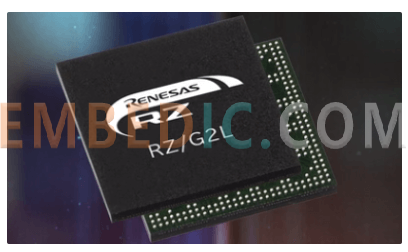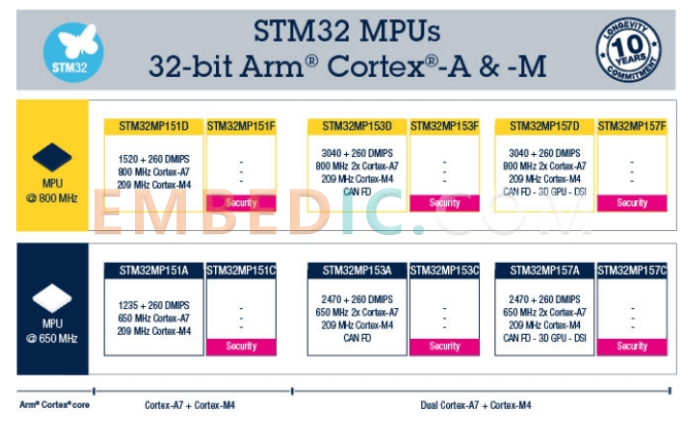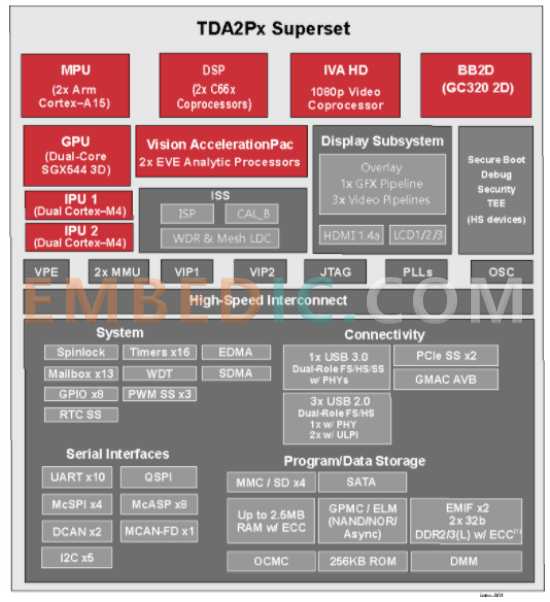In the last issue, we mentioned that MPUs have a wide range of applications for high-resolution human-machine interfaces, embedded vision, embedded artificial intelligence (e-AI), real-time control, and industrial Ethernet connectivity. MPUs are the mainstream choice for computer-intensive industrial and consumer applications with Linux or Android-based operating systems that require a large number of high-speed connections or user interfaces with a wide range of functions. The mainstream choice is not the only choice. In the face of vision applications, there are also major manufacturers that do it through SoCs in order to enhance reliability.
Today we switch the entry point from industrial Ethernet to vision applications, where the top processor vendors have done a feature-rich development in this class of applications.
RA's RZ series, as a high-end microprocessor based on 32-bit and 64-bit Arm, is very distinctive in the MPU field. The N series for industrial Ethernet applications in the last issue was impressive. And the G series launched for graphics, multi-stream video and embedded vision is also powerful in performance.

(RZ/G series, RA)
The G1 series is a 32-bit MPU with 1GHz+ Arm Cortex-A cores. Within the G1 series, the RZ/G1H MPU is RA's highest combined strength processor for general-purpose, graphics and video applications. It is equipped with a quad-core Cortex-A15 (1.4 GHz) and quad-core Cortex-A7 (780 MHz) CPU, two 32-bit DDR3 interfaces, a 3D graphics engine and two dedicated channels for hardware-accelerated encoding and decoding of Full HD video. the high performance of the RZ/G1HF MPU enables it to perform image recognition and authentication on multiple video streams these high-performance image processes. This MPU is equipped with a full range of functional peripherals such as high-speed USB, SATA interfaces, and more.
The G2 series, on the other hand, is a 64-bit MPU with a multi-core architecture. this family of microprocessors combines a powerful 64-bit multi-core architecture with advanced graphics capabilities and a high-bandwidth memory interface, perfectly suited to the high performance, high reliability and long-term software support required by developers using embedded controllers.
With the 64-bit ARM V8-A core and a powerful graphics engine, 4K UHD video engine, the G2's multi-core portfolio scales from low-end to high-end applications, delivering up to 35.6kDMIP in a single package, it is safe to say that the G2 family offers the highest performance visual processing power available. Performance is high enough, what about reliability? For critical system tasks, the G2 has built-in ECC error correction codes on internal and external memory, as well as high-speed protocols of up to 3200MT/s DDR3L and LPDDR4 for external memory. As for data security, the G2 series implements a secure platform through hardware features including Arm TrustZone partitioning, secure key generation and storage, and more.
The G series expands quite a bit on the A series and has absolute high-end performance for machine vision applications.
The STM32 family of general-purpose 32-bit MPUs integrates the heterogeneous architecture of Arm Cortex-A and Cortex-M cores to achieve a high-performance and flexible multi-core architecture and image processing capabilities with low power consumption.

(ST MPU Matrix, ST)
Machine vision applications today require specific embedded designs to manage high processing loads and complex applications with vision. In the face of these demands, ST leverages the power of open source software stacks while maintaining low power consumption and real-time performance.
The STM32MP151A is selected for the STM32 family of general purpose 32-bit MPUs with dual-core heterogeneous architectures that are not very different in terms of image processing capabilities. The other processor, Cortex-A7, comes with multiple caches.
The other processor, Cortex-M4, has a single-precision floating-point unit (FPU) that supports single-precision data processing instructions and data types. cortex-M4 supports a full set of DSP instructions and a memory protection unit that enhances application security, and is absolutely adequate for performance in machine vision processing. It can be said that ST's MPU is extremely cost-effective.
In vision analysis applications, TI has launched only this one series of SoC. this series can be applied to vehicle-grade complex embedded vision technology.

(TDA2P series, TI)
TDA2P series combines the best performance, low power consumption and vision analysis processing functions, is specifically developed for ADAS applications. TDA2P series is a scalable architecture, unfolded which contains TI's DSP generation core, Vision AccelerationPac, Arm Cortex-A15 MPCore and dual Cortex-M4 processor combination.
The dual-core A15 microprocessor subsystem, along with two C66x series floating-point DSPs performing up to 32 16 x 16-bit fixed-point multiplications per cycle, can handle 1920 x 1080p, 60fps Full HD video. The family also integrates a video gas pedal and a graphics gas pedal for rendering virtual views, thus enabling a 3D visual experience. The Vision AccelerationPac mentioned above, on the other hand, contains multiple embedded vision engines, so the application processor does not have to perform visual analysis functions, greatly reducing power consumption. The TDA2Px is also highly integrated in terms of peripherals, including an LVDS surround view system, display, CAN and Gigabit Ethernet AVB. the performance of this SoC, which enables sophisticated embedded vision technology, is unquestionable.
Both MPUs and SoCs are widely used in machine vision applications. SoCs offer more full functionality than MPUs, but their complexity and system requirements for design and manufacturing processes are higher, as is the cost, naturally. In autonomous driving definitely SoC is more suitable, for general industrial grade consumer vision applications, MPU is still the most popular choice.
Manufacturer: Microchip
IC MCU 8BIT 64KB FLASH 44TQFP
Product Categories: 8bit MCU
Lifecycle:
RoHS:
Manufacturer: Texas Instruments
IC DSP FIXED-POINT 737FCBGA
Product Categories: DSP
Lifecycle:
RoHS:
Manufacturer: Texas Instruments
IC DSP FLOATING POINT 256BGA
Product Categories: DSP
Lifecycle:
RoHS:
Manufacturer: Microchip
IC MCU 8BIT 32KB FLASH 44QFN
Product Categories: 8bit MCU
Lifecycle:
RoHS:
Looking forward to your comment
Comment